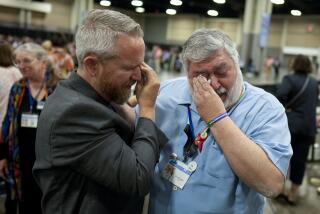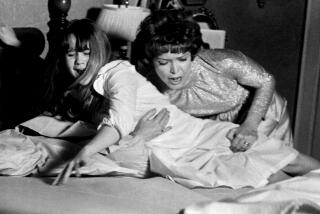In a New Age, Exorcists Get a New Rule Book
- Share via
The Roman Catholic Church, emphasizing its continued belief in the literal existence of the devil, has added some new twists to its age-old fight with Satan.
For the first time in 385 years, the Vatican on Tuesday issued new guidelines for performing exorcisms--a religious rite for driving evil out of the demon-possessed.
“The existence of the devil isn’t an opinion, something to take or leave as you wish,” Cardinal Jorge Arturo Medina Estevez said in Vatican City. “Anyone who says he doesn’t exist wouldn’t have the fullness of the Catholic faith.”
There are “no radical changes” in the new guidelines, although the fact that new rules are needed at all might strike some as odd. Yet while exorcisms may seem like something out of the Middle Ages--or Hollywood--they are still performed.
Pope John Paul II, who arrived Tuesday in St. Louis, once performed an exorcism himself, according to the memoirs of Cardinal Jacques Martin, the former prefect of the pontifical household.
In the last three years alone, Father James LeBar, chief exorcist in the New York archdiocese, and three other New York exorcists have investigated 80 cases throughout the country, including “a few” in Los Angeles, LeBar said Tuesday.
The Los Angeles archdiocese has at least one priest authorized to perform exorcisms.
“Evil is as present today as in any other age,” LeBar said.
In addition to collective evil, such as the Holocaust or the Cambodian genocide of the 1970s, LeBar said, individual evil remains, frequently showing up as criminal activity and hate.
LeBar stressed that the church continues to believe that Satan is an actual spiritual being.
“Evil is a force, yes,” LeBar said. “But Satan is a . . . creature of God, a [fallen] angel who sometimes possesses people. . . . When there is a real possession, then the ritual is used.”
Among the widely accepted signs of possession by the devil are unnatural strength, an ability to speak languages one has never studied, clairvoyance and levitation. Those believed to be possessed are also repelled by the sight of a cross and by holy water and will refuse to enter a sanctified place of worship, the church believes.
Estevez said cases of demonic possession are “very rare.” Contrary to Hollywood depictions such as those in the 1973 film “The Exorcist,” where a possessed girl’s head spun around and her bed rose into the air, the sinister influence of the devil more commonly plays out as deception, falsehood, lies and confusion, Estevez said.
The new guidelines, so far available only in Latin, appear to stress the importance of a full medical and psychological evaluation of a person supposedly possessed by diabolical entities or forces before the church permits an exorcism.
In a commentary on the new rite made available Tuesday to The Times, a priest with the National Conference of Catholic Bishops in Washington said an exorcist must exercise “maximum circumspection and prudence,” approaching the person suspected of being possessed as he would anyone suffering from physical or psychological illness.
“The exorcist decides whether a person is possessed after a diligent investigation, including extensive consultation with spiritual, medical and psychological experts,” wrote Father James P. Moroney, executive director of the bishops’ Secretariat for the Liturgy. Only a priest specifically authorized by his bishop is permitted to perform an exorcism.
That has already been the rule in the Los Angeles Archdiocese, according to Father Gregory Coiro, the archdiocesan spokesman. Only if a battery of medical and psychological tests fails to find the cause or reason for a person’s behavior would “we begin entertaining the notion that perhaps something supernatural is going on,” Coiro said.
The guidelines also delete more “imaginative” descriptions of the devil in keeping with the church’s understanding of the devil as “a spirit without body, without color and without odor.”
LeBar, who has examined the revisions, said the guidelines continue to give exorcists the discretion to use the old language as laid out in the Roman Rite of Exorcism of 1614.
“Sometimes in casting out some particularly stubborn devils,” he said, “the older forms with the horrible-sounding names may be just what’s needed to put the devil to flight.”
More to Read
Sign up for Essential California
The most important California stories and recommendations in your inbox every morning.
You may occasionally receive promotional content from the Los Angeles Times.













